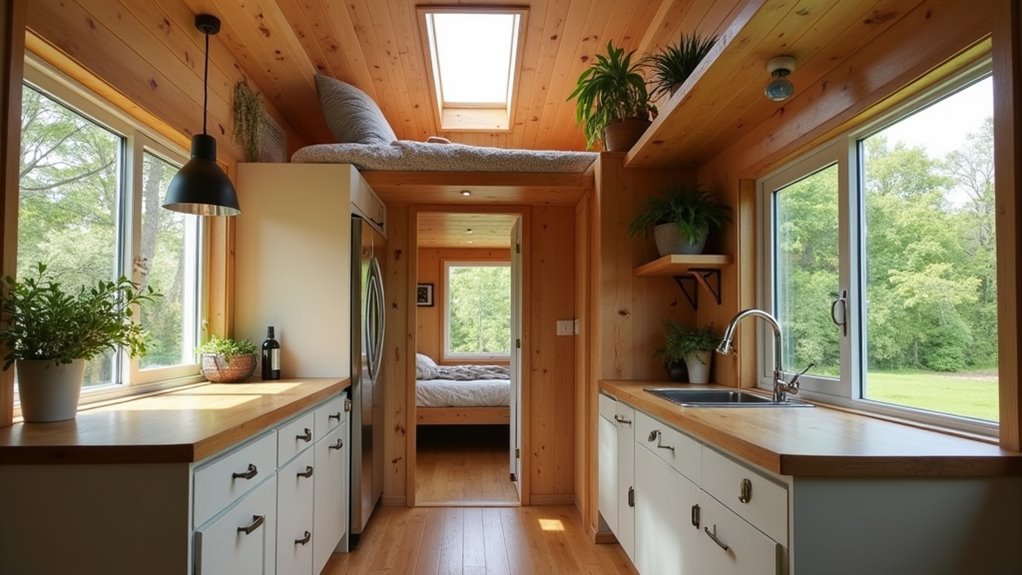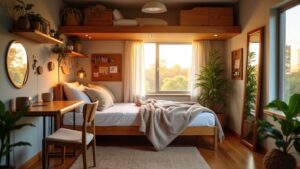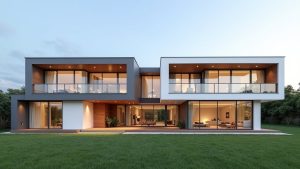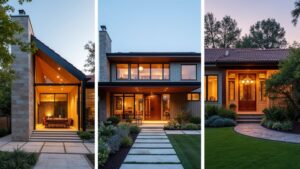To maximize space in tiny houses, consider these seven design ideas: embrace minimalist principles for functionality, utilize multi-functional furniture, and implement innovative storage solutions. Open concept layouts enhance flow and natural light, while strategic room divisions create distinct spaces without sacrificing openness. Don’t overlook the importance of vertical storage and enhancing ventilation with strategically placed windows. Incorporating trendy elements can elevate the aesthetics—discover how these strategies can transform compact living into a harmonious experience.
Key Takeaways
- Embrace minimalist design principles to create a functional living environment in tiny homes.
- Opt for multi-functional furniture, like sofa beds and foldable tables, to maximize versatile use of space.
- Implement innovative storage solutions, such as under-stair compartments and built-in shelves, to utilize every inch effectively.
- Utilize open concept layouts to enhance natural light and create a visually cohesive atmosphere throughout.
- Incorporate strategic room divisions using sliding panels or bookcase walls to define spaces without sacrificing flow.
Optimizing Space With Smart Design Choices
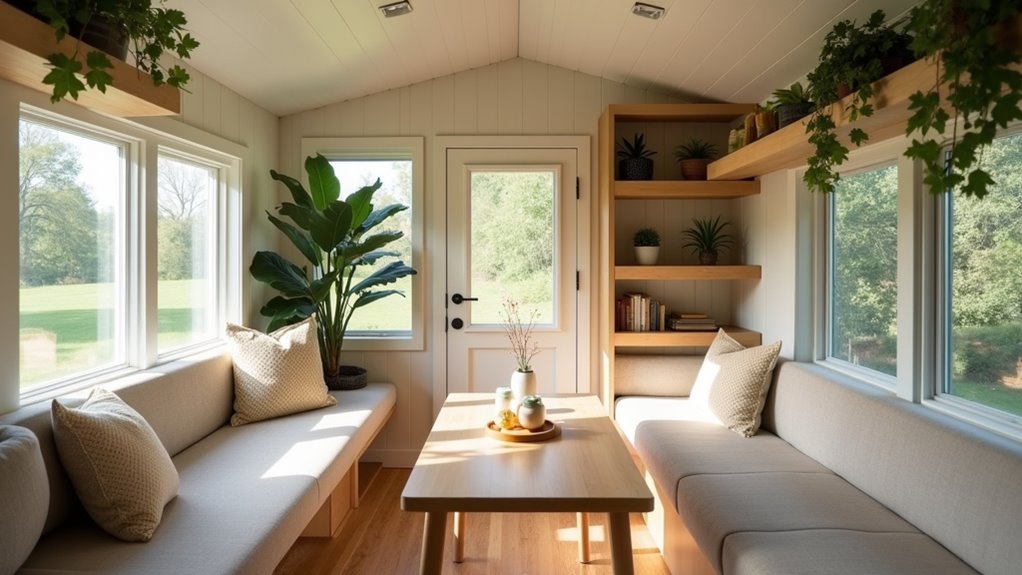
In the quest for a functional and harmonious tiny house, optimizing space with smart design choices becomes essential.
Adopting minimalist design principles, homeowners can select multi-functional pieces, such as sofa beds that serve dual purposes for seating and sleeping. Built-in furniture like benches with storage and wall-mounted desks helps maximize efficiency. Multi-functional and Custom Furniture is key to creating versatile living areas that seamlessly adapt to various needs. Additionally, incorporating innovative storage solutions can help utilize every inch of available space effectively.
Fold-out tables enable flexible layouts, accommodating dining or workspace needs, while storage ottomans provide extra seating and conceal items. Vertical storage solutions, like floor-to-ceiling shelves and magnetic strips, further enhance organization. Embracing hidden storage ideas, such as bed drawers and under-stair compartments, makes efficient use of every nook. Vertical space is often underutilized, yet offers valuable storage opportunities in tiny homes, reinforcing the importance of smart design choices.
Ultimately, these smart choices create a dynamic environment, allowing for adaptability over time and fostering a sense of spaciousness.
Embracing Open Concept Layouts
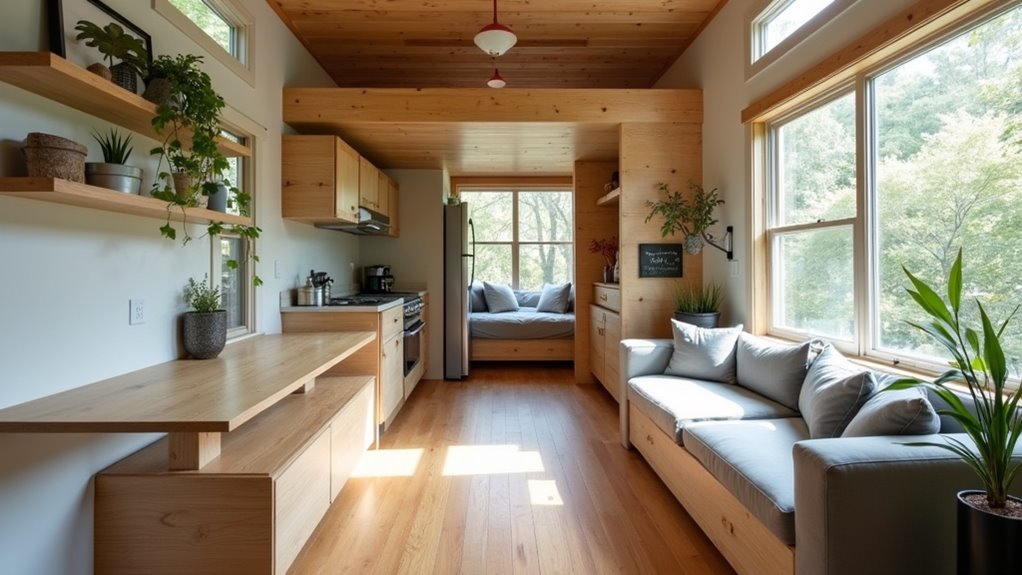
While creating a tiny house, embracing open concept layouts transforms limited spaces into versatile havens that prioritize functionality and flow.
By minimizing interior walls, these designs enhance natural light, fostering a brighter environment. Open layouts promote visual continuity, creating seamless sightlines that extend the perception of space.
Multifunctional areas—where kitchen, dining, and living spaces coalesce—enable efficient use of every inch while ensuring adaptable furniture arrangements. Improved traffic flow allows for easy movement, making it comfortable for families and guests alike.
Additionally, strategic window placements and unobstructed views amplify energy efficiency and aesthetic appeal. Incorporating sustainable design elements can further enhance overall comfort and style in small spaces.
In essence, open concept designs not only maximize space but also cultivate a cohesive atmosphere that reflects modern living.
Utilizing Strategic Room Divisions
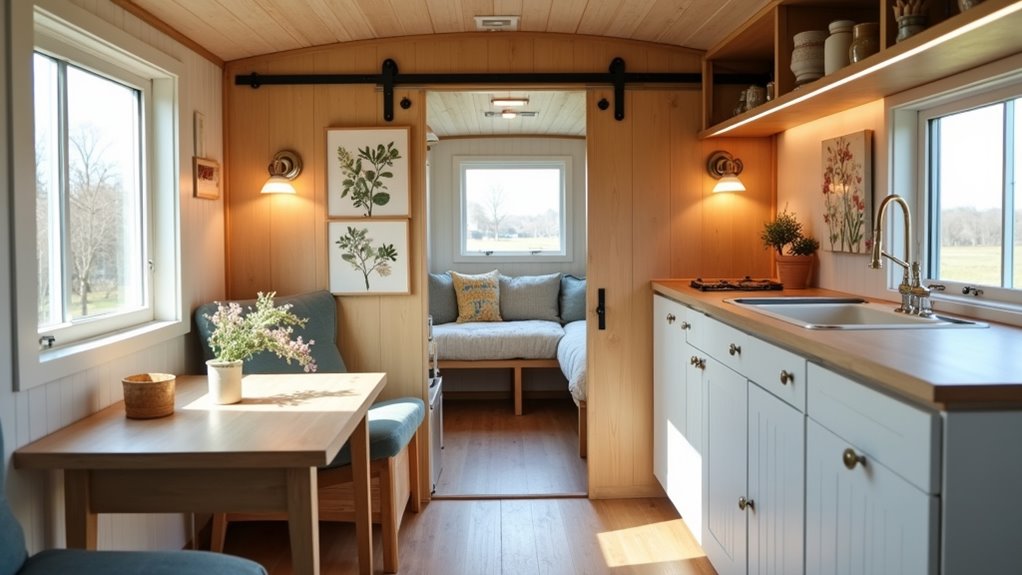
Creating distinct yet harmonious areas within a tiny house enhances the functionality of limited space.
Employing partition techniques like bookcase walls, folding screens, or sliding panels provides both visual and physical division without costly construction.
Partition techniques like bookcase walls and folding screens offer affordable, stylish ways to divide spaces in a tiny home.
Utilizing furniture placement as barriers, such as sectional sofas or multifunctional bookshelves, not only defines spaces but also serves dual purposes.
Area rugs and varied flooring can delineate zones through texture and color, creating a subtler separation.
Additionally, wall-mounted or foldable solutions maximize floor space while offering temporary privacy.
By integrating contrasting colors, lighting, and materials, one can craft visually appealing transitions that maintain cohesion in design. Incorporating room dividers strategically can enhance both aesthetics and functionality, allowing for a more versatile use of space.
These strategies effectively transform a compact home into a versatile and inviting environment.
Maximizing Storage Solutions
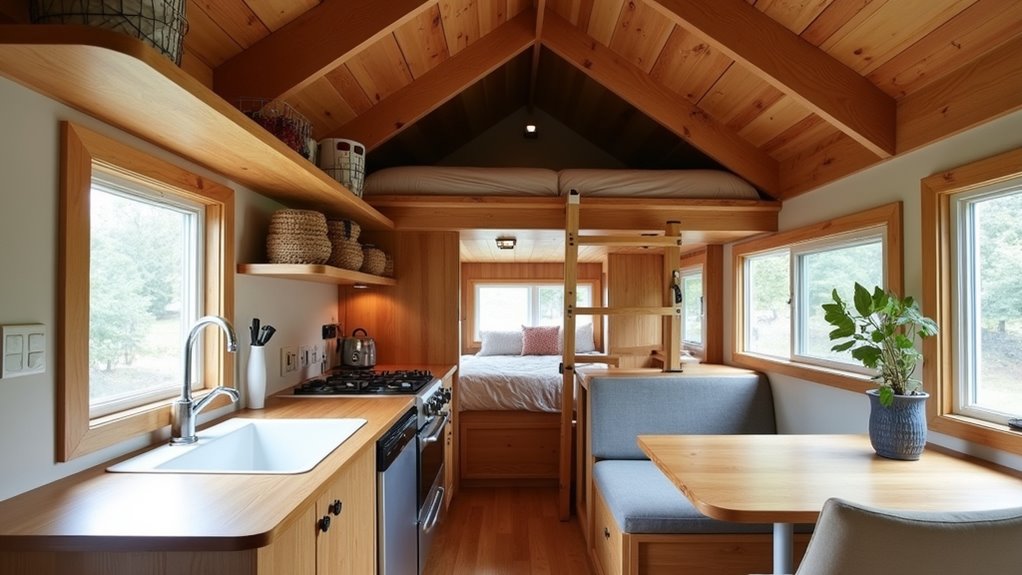
Maximizing storage solutions in a tiny house not only enhances organization but also transforms the living experience into one of efficiency and comfort. Smart use of vertical shelving, hidden storage options, and multipurpose features can elevate any small space.
| Storage Solution | Description |
|---|---|
| Tall Shelving Units | Extend close to the ceiling |
| Under-Bed Drawers | Utilize space beneath furniture |
| Fold-Down Desks | Create workstations or dining areas |
| Pegboards | Organize tools and utensils |
| Modular Cubes | Rearrange based on needs |
Incorporating Multi-Functional Furniture
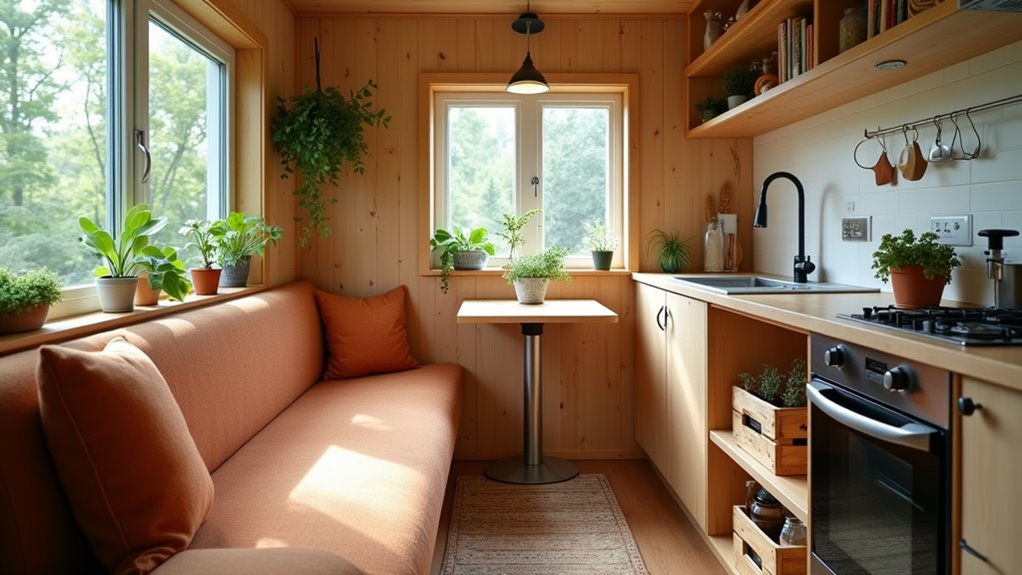
In small living spaces, the challenge of efficiently using limited square footage can be tackled by incorporating multi-functional furniture. This approach enables homeowners to maximize their living areas through versatile seating options like ottomans that double as storage units or sofa beds that transform into sleeping spaces.
Compact designs such as foldable tables and Murphy beds save floor space while providing efficient storage solutions. Modular layouts enhance flexibility, allowing furniture to be rearranged as per different needs.
Moreover, selecting sustainable materials not only promotes eco-friendliness but also ensures durability. By choosing multi-functional pieces, tiny homeowners can reduce clutter and maintain comfort, making the most of their cozy environments while simplifying daily living and upkeep.
Enhancing Natural Light and Ventilation
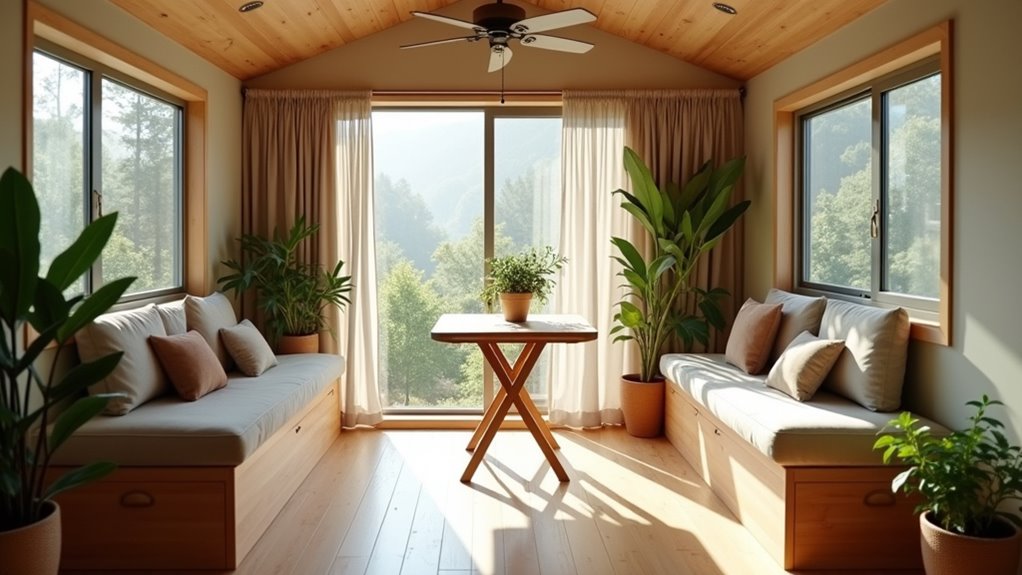
Natural light and proper ventilation play crucial roles in cultivating an inviting atmosphere within tiny homes.
Effective design elements can significantly enhance both sunlight exposure and airflow, contributing to a healthier living environment.
Well-constructed design features can optimize natural light and airflow, fostering a healthier and more inviting living space.
- Window Placement: Strategically positioned windows capture natural light and encourage fresh airflow.
- Skylights and Solar Tubes: These additions illuminate central spaces where wall windows fall short.
- Reflective Surfaces: Incorporating mirrors and glossy finishes amplifies light, creating the illusion of spaciousness.
- Cross-Ventilation Techniques: Opposing windows promote effective air exchange and circulation.
- Energy Efficiency: Relying on natural light reduces artificial lighting needs, ultimately conserving energy.
Staying Abreast of Current Design Trends

As homeowners embrace the charm of tiny living, staying updated with the latest design trends becomes essential for creating functional and stylish spaces.
Current color trends highlight the appeal of flamboyant tones paired with earthy neutrals, adding warmth and contrast that make compact environments feel larger.
Two-tone minimalist aesthetics, combined with color drenching techniques, create a unified, modern appearance.
Multi-functional furniture and bespoke designs optimize space, while layered and aesthetic lighting enhances mood and function, ensuring adaptability.
Sustainable materials, like reclaimed wood and low-VOC finishes, promote eco-conscious lifestyles.
Incorporating biophilic elements, such as natural textures and indoor plants, fosters a serene atmosphere, completing the vision of a contemporary tiny home infused with purpose and tranquility.
